Schoenus ligulatus
Schoenus ligulatus is a species of sedge endemic to the western regions of the Western Cape Province of South Africa.[1]
| Schoenus ligulatus | |
|---|---|
 | |
| Strap veldrush | |
| Scientific classification | |
| Kingdom: | Plantae |
| Clade: | Tracheophytes |
| Clade: | Angiosperms |
| Clade: | Monocots |
| Clade: | Commelinids |
| Order: | Poales |
| Family: | Cyperaceae |
| Genus: | Schoenus |
| Species: | S. ligulatus |
| Binomial name | |
| Schoenus ligulatus (Boeckeler) Kuntze | |
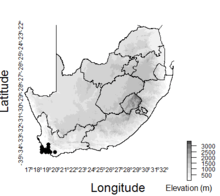 | |
| Documented collection localities | |
| Synonyms[1] | |
| |
Description
The key diagnostic character of S. ligulatus are its linear-lanceolate spikelets and narrow elliptic nutlets.[1]
Schoenus exilis resembles S. ligulatus, but the former is a shorter species (<350 mm) compared to the taller S. ligulatus (>350 mm).[1] In addition, the spikelets of S. exilis are shorter (mostly <4.5 mm) compared to those of S. ligulatus.[1] Another key difference between the two species is that S. exilis often has membranaceous ligules, whereas the ligules of S. ligulatus tend to be firmer.[1]
Schoenus quartziticus is also a similar species; however, it has broad elliptic nutlets and shorter spikelets (<4.0 mm) compared to those of S. ligulatus.[1]
Similar to other sedges, plants in this group are very difficult to identify. It appears that part of this problem is caused by the tendency of the southern African Schoenus to form hybrids with each other.[2] It appears that Schoenus ligulatus forms hybrids with other southern African Schoenus species, specifically Schoenus cuspidatus.[1]
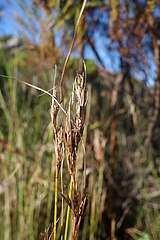 Flowering heads
Flowering heads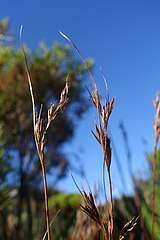 Flowering heads
Flowering heads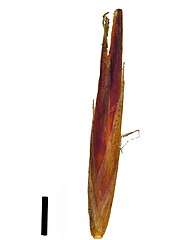 Spikelet (black scale bar represents 1 mm)
Spikelet (black scale bar represents 1 mm)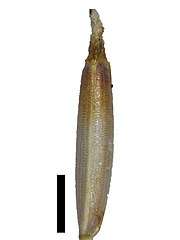 Nutlet (black scale bar represents 1 mm)
Nutlet (black scale bar represents 1 mm)
Taxonomy
Schoenus ligulatus is a species in family Cyperaceae, tribe Schoeneae.[1] Other notable genera in tribe Schoeneae include Lepidosperma, Oreobolus, Costularia, Tetraria and Gahnia.[1][3][4] The most closely related species to S. ligulatus are other southern African Schoenus species, specifically, species in the S. cuspidatus and allies group.[1]
Southern African Schoenus were once classified as Tetraria; however, based on molecular and morphological differences, we now know that the two groups are evolutionary distinct.[5] To ensure that this group of sedges is monophyletic (i.e. the genus only has closely related species), the southern African Tetraria were transferred into Schoenus.[5] In the field, the southern African Schoenus can be distinguished from Tetraria species by their lack of stem leaves and the absence of reticulate sheaths at the bases of the flowering stems.[5]
Distribution and habitat
Schoenus ligulatus is a species of sedge found in the western areas of the Western Cape Province of South Africa. [1] This species generally occurs in wet habitats, but it can also be found growing on drier sites. The reported elevation range of S. ligulatus is between 100 and 750 m.[1]
Images
 Growth form of Schoenus ligulatus
Growth form of Schoenus ligulatus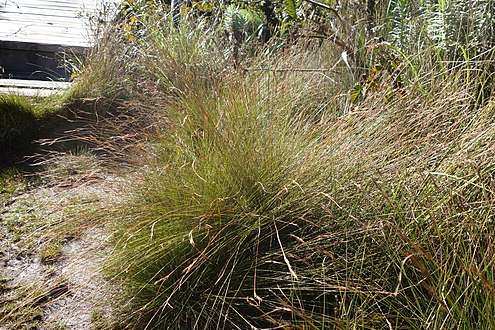 Growth form of Schoenus ligulatus
Growth form of Schoenus ligulatus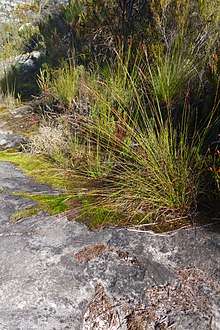 Growth form of Schoenus ligulatus
Growth form of Schoenus ligulatus
References
- Elliott, T.L.; Barrett, R.L.; Muasya, A.M. (2019). "A taxonomic revision of Schoenus cuspidatus and allies (Cyperaceae, tribe Schoeneae)—Part 1". South African Journal of Botany. 121: 519–535. doi:10.1016/j.sajb.2018.11.021.
- Levyns, M. (1947). "Tetraria and related genera, with special reference to the flora of the Cape Peninsula". Journal of South African Botany. 13: 73–93.
- Viljoen, J.-A.; Muasya, A.M.; Barrett, R.L.; Bruhl, J.J.; Gibbs, A.K.; Slingsby, J.A.; Wilson, K. L.; Verboom, G.A. (2013). "Radiation and repeated transoceanic dispersal of Schoeneae (Cyperaceae) through the southern hemisphere". American Journal of Botany. 100 (12): 2494–2508. doi:10.3732/ajb.1300105.
- Larridon, I.; Bauters, K.; Semmouri, I.; Viljoen, J.-A.; Prychid, C.J.; Muasya, A.M.; Bruhl, J.J.; Wilson, K.L.; Senterre, B.; Goetghebeur, P. (2018). "Molecular phylogenetics of the genus Costularia (Schoeneae, Cyperaceae) reveals multiple distinct evolutionary lineages". Molecular Phylogenetics and Evolution. 126: 196–209. doi:10.1016/j.ympev.2018.04.016.
- Elliott, T.L.; Muasya, A.M. (2017). "Taxonomic realignment in the southern African Tetraria (Cyperaceae, tribe Schoeneae; Schoenus clade)". South African Journal of Botany. 112: 354–360. doi:10.1016/j.sajb.2017.06.011.